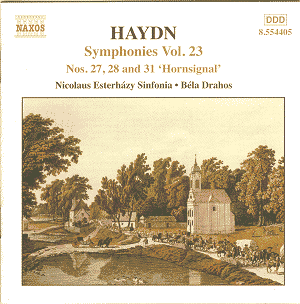HAYDN
Symphony no 27 in G major
Symphony no 28 in A major
Symphony no 31 in D major (Hornsignal)
 Nicolaus Esterhazy Sinfonia/Bela
Drahos
Nicolaus Esterhazy Sinfonia/Bela
Drahos
Recorded February 1998
 NAXOS 8.554405
[62.41]
NAXOS 8.554405
[62.41]
Crotchet AmazonUK
AmazonUS

These three early Haydn symphonies date from the 1760s when the composer
was settling into his long and fruitful association with the court of the
Princes Esterhazy. In addition to strings and continuo numbers 27 and 28
have only two oboes and two horns. In both symphonies, the slow movement
is entrusted to muted strings. These are brief and relatively lightweight
works, though brimming with the composer's customary inventiveness, charm,
wit and energy. The finale of number 28 is particularly chirpy.
The 'Hornsignal' symphony has long been the most popular of Haydn's early
symphonies. Though written in the same year as number 28 it is a much longer
work; and it shows remarkable structural and stylistic advances over anything
that had gone before. As well as strings, continuo and the usual pair of
oboes it calls for two pairs of horns (in G and D) and extensive passages
for solo flute, violin, cello and double bass. With these additional forces
at his disposal Haydn produced a miracle of invention. Apart from the majestic
writing for the horns (usually hunting in pairs, but brought together at
the beginning and end of the work to thrilling effect) the piece is notable
its wonderfully varied dialogues between the solo instruments. In the robust
Minuet it is the turn of the oboes to shine. The finale is a felicitous set
of variations.
At Naxos prices this disc is worth buying just for the Hornsignal
symphony which is here delivered with the utmost panache: the horn playing
in particular is electrifying. The sound is clear and spacious. A terrific
disc!
Adrian Smith

